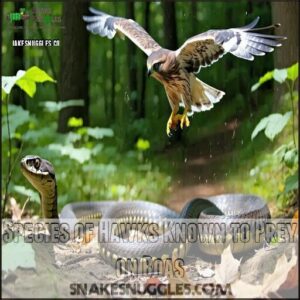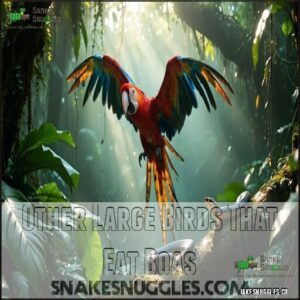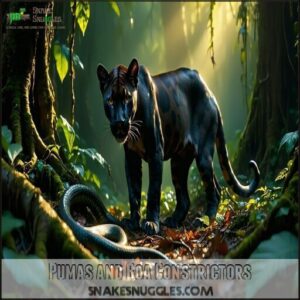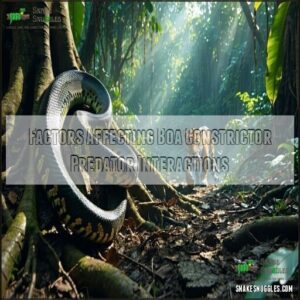This site is supported by our readers. We may earn a commission, at no cost to you, if you purchase through links.
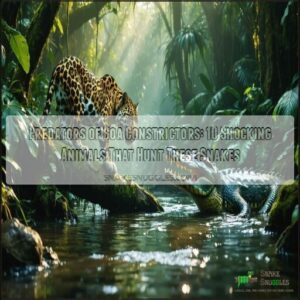
Young boas are particularly vulnerable to hawks, caimans, wild pigs, and coatis. As they grow, their predator list shrinks, but adult boas still need to watch out for jaguars and crocodiles.
Humans remain their primary threat through hunting and habitat destruction. In the wild, these powerful snakes must constantly balance between being predator and prey, using their camouflage and strength for survival.
Understanding these complex relationships reveals fascinating adaptations that have evolved over millions of years in these remarkable reptiles.
Table Of Contents
- Key Takeaways
- Boa Constrictor Predators in The Wild
- Large Birds Preying on Boa Constrictors
- Reptiles and Amphibians That Eat Boa Constrictors
- Mammals That Prey on Boa Constrictors
- Factors Affecting Boa Constrictor Predator Interactions
- Frequently Asked Questions (FAQs)
- How Long Can Boa Constrictors Live in the Wild?
- Are Boa Constrictors on the Endangered Species List?
- What Methods Do Boa Constrictors Use to Capture Prey?
- How Can Humans Protect Boa Constrictors From Extinction?
- Are Boa Constrictors Dangerous to Humans?
- Does the boa constrictor have any predators?
- What eats a boa constrictor in the rainforest?
- Can a jaguar eat a boa constrictor?
- What threatens a boa constrictor?
- What is the largest prey of the boa constrictor?
- Conclusion
Key Takeaways
- You’ll find that young boa constrictors face numerous predators, including hawks, caimans, wild pigs, and coatis, while adults primarily need to watch out for jaguars and crocodiles.
- Despite their impressive size and strength, boa constrictors aren’t at the top of the food chain, using camouflage, hissing, and musk emission as defense mechanisms against predators.
- Humans remain the greatest threat to boa constrictors through hunting for skins, habitat destruction, and capturing them for the pet trade.
- Habitat loss, climate change, and human activities significantly disrupt natural predator-prey relationships, forcing unusual encounters between species and affecting the survival rates of both boas and their predators.
Boa Constrictor Predators in The Wild
You’ll find that even these powerful constrictors aren’t at the top of the food chain, with predators including eagles, hawks, caimans, alligators, jaguars, and humans posing significant threats.
Young boas are particularly vulnerable to predation as they lack maternal protection, while adults gain some safety through their impressive size and defensive capabilities like camouflage, hissing, and musk emission.
Young boas face the wild without mother’s protection, relying only on camouflage, hissing, and pungent musk to survive predator encounters.
Reptilian Predators of Boa Constrictors
In the reptilian world, boa constrictors face several formidable enemies despite their own predatory nature.
These powerful snakes must constantly watch for larger reptilian threats.
Five reptilian predators that hunt boa constrictors:
- Caimans, particularly Black Caimans, with their powerful jaws
- Large Crocodile species in shared wetland habitats
- American Alligators, especially in Florida’s Everglades
- Larger snake species like Anacondas
- King Cobras, known for eating other snake species
Juvenile boa constrictors are particularly vulnerable to these reptilian competitors.
Their defense strategies include camouflage and remaining motionless to avoid detection by these dangerous reptilian predators.
The boa’s sleek scales enhance adaptability, aiding in their survival.
Avian Predators of Boa Constrictors
Soaring high above the forest canopy, eagles and hawks represent serious threats to boa constrictors in the wild.
These avian predators primarily target juvenile boas, using their exceptional eyesight and powerful talons to snatch unsuspecting snakes.
White-bellied sea eagles and wedge-tailed eagles display remarkable hunting tactics, while hawks demonstrate precise juvenile predation skills.
Bird migration impacts predation patterns, with nesting site vulnerability increasing during certain seasons.
Mammalian Predators of Boa Constrictors
While large birds swoop down from above, it’s the mammals that hunt boas from the forest floor. The domain of mammalian predators presents serious challenges for boa constrictors in their natural habitats.
Jaguars stand as the most formidable mammals that prey on boas, using their powerful jaws and strength to overpower even adult snakes. Pumas follow closely, relying on stealth and agility to target younger or smaller boas. Ocelots, though smaller than their big cat relatives, still pose a significant threat to juvenile constrictors.
- Jaguars use their raw power to defeat boas in direct confrontations
- Pumas strike with stealth, often targeting vulnerable young snakes
- Ocelots hunt smaller boas in shared forest habitats
- Wild dogs occasionally attack boas through coordinated pack strategies
Humans remain the most significant mammalian threat, hunting boas for their skins and meat.
Common Boa Constrictor Predator Habitats
While we’ve examined the mammals that hunt boa constrictors, understanding where these predators live gives us vital insight into their hunting success.
Boa constrictor predators inhabit remarkably diverse ecosystems. You’ll find them lurking in dense forest canopies where jaguars and large birds patrol for unsuspecting snakes. In murky swamp basins, caimans and crocodiles silently glide through waters where young boas often venture.
Mountain regions host eagles and hawks that spot boas from impressive heights, while even arid deserts harbor specialized snake predators adapted to harsh conditions.
Understanding the ideal boa habitat is also key to understanding their vulnerability. Habitat fragmentation increasingly forces these natural enemies into closer proximity, creating new dynamics between boa constrictors and their predators that researchers continue to study.
Large Birds Preying on Boa Constrictors
You’ll be surprised to learn that powerful birds like eagles and hawks are among the most effective predators of young boa constrictors in the wild.
White-bellied sea eagles and wedge-tailed eagles specifically target juvenile boas, swooping down to capture these serpents before they grow large enough to defend themselves, which makes them effective predators.
Species of Hawks Known to Prey on Boas
Several hawk species have evolved specialized hunting tactics to prey on young boa constrictors.
While moving from general predator discussion to specific hawk species, it’s worth noting their remarkable adaptations.
Hawks target juvenile boas with deadly precision using:
- Exceptional aerial vision that detects even camouflaged snakes
- Silent hovering techniques that prevent detection before striking
- Powerful talons designed to penetrate scales and immobilize prey
- Strategic hunting times when young boas are most exposed
Red-tailed Hawks and Cooper’s Hawks frequently patrol areas where juvenile boas reside. Their keen eyesight allows them to spot the slightest movement below, rendering a young boa’s camouflage nearly useless.
The overlap between hawk territories and boa habitats creates consistent predation pressure, though boas have developed defensive mechanisms like freezing and seeking dense cover. This predator-prey relationship impacts both hawk and boa populations throughout their range.
Eagles and Boa Constrictors
While hawks target boas with precision, eagles represent an even more formidable threat to these powerful snakes.
White-bellied Sea Eagles and Harpy Eagles specifically hunt juvenile boa constrictors with remarkable efficiency.
Their eagle hunting tactics overcome boa camouflage effectiveness through:
- Lightning-fast dives exceeding 120 mph that give boas no escape time
- Powerful talons that easily penetrate snake scales despite defensive hissing
- Keen eyesight that spots camouflaged boas from 2+ miles away
- Strategic attacks targeting the snake’s head to prevent constriction
Other Large Birds That Eat Boas
Beyond eagles, the domain of aerial boa predators extends to several other impressive birds.
When you spot these winged hunters in action, you’ll notice their specialized techniques for targeting these formidable snakes.
- Macaws with their powerful beaks can attack juvenile boas when nesting proximity creates territorial conflicts, particularly in South American rainforests
- King vultures occasionally target injured or young boas despite their reputation as scavengers, using their sharp beaks to tear into snake flesh
- Secretary birds, known for their snake-stomping hunting techniques, use powerful kicks to subdue small boas in African regions where these snakes have been introduced
- Marabou storks with their massive bills opportunistically prey on juvenile boas in wetland areas
Regional variations in bird size affect predation patterns, with larger species more capable of handling adult boas.
Young boas are vulnerable to airborne attacks from hawks.
Conservation status of these birds influences predator-prey dynamics, as declining populations of these natural predators can lead to increased boa populations in some ecosystems.
Reptiles and Amphibians That Eat Boa Constrictors
You’ll find it surprising that several reptiles and amphibians regularly hunt and consume boa constrictors in their natural habitats.
Caimans and alligators pose significant threats to young boas with their powerful jaws and stealthy hunting techniques, while large crocodiles can overpower even adult specimens.
Snakes That Prey on Boa Constrictors
While boa constrictors rule their domain, they sometimes fall prey to other snake species.
In the predator-prey dynamics of the snake world, interspecies competition can turn deadly:
- King snakes – specialized snake-eaters with remarkable immunity to venom
- King cobras – renowned snake hunters that target various serpent species
- Womas and Blackheads – Australian pythons that particularly enjoy consuming other snakes
- Boa constrictors themselves – rare cases of cannibalism have been documented among boas
Snake cannibalism plays a significant role in structuring snake communities.
While generally not preying on other boids, there have been instances of boas exhibiting rare cannibalistic behavior.
Crocodiles and Boa Constrictors
Crocodiles tower over boa constrictors in the predator hierarchy of tropical ecosystems.
With jaw strength reaching 3,700 PSI, these massive reptilian predators can snap up adult boas with ease.
Habitat overlap in Central and South American waterways creates frequent predation opportunities, especially during dry seasons when both species concentrate around shrinking water sources.
Boas have few defense mechanisms against crocodiles, making these aquatic enemies among their most formidable threats despite conservation efforts to protect both species.
Caimans as Boa Constrictor Predators
While crocodiles pose significant threats to boa constrictors, caimans remain equally formidable predators in shared wetland ecosystems.
These stealthy reptiles employ sophisticated caiman hunting tactics when targeting boas, particularly in areas with significant caiman habitat overlap.
- Black caimans, with their massive size advantage, easily overpower adult boas despite their muscular defenses
- Spectacled caimans excel at nighttime ambushes when boa vulnerability factors are highest
- Juvenile boa predation occurs frequently, as young caimans perfect their hunting techniques on smaller targets
The powerful jaws of caimans strike with lightning-fast precision, leaving little chance for escape and contributing to significant caiman population impact on local boa numbers.
Other Reptiles That Eat Boa Constrictors
While caimans are formidable hunters of boa constrictors, several other reptiles also prey on these powerful snakes.
Beyond their watery domains, various cold-blooded predators share and compete within the same ecosystems.
- Large alligators can overpower even adult boas, particularly when the snakes venture near water sources
- Instances of snake cannibalism occur when larger constrictors encounter smaller ones, especially during food scarcity
- Monitor lizards opportunistically target juvenile boas, exploiting their vulnerability before they reach full size
Reptile competition is particularly intense in areas with invasive reptiles, where established food chains become disrupted. The reptilian threat to boas highlights how these impressive predators can themselves become prey in nature’s complex hierarchy, showing the delicate balance of ecosystems.
Mammals That Prey on Boa Constrictors
You’ll be surprised to learn that powerful mammals like jaguars, pumas, and ocelots hunt boa constrictors in tropical regions despite the snake’s own predatory capabilities.
These skilled hunters use their speed, sharp claws, and powerful jaws to overcome boas, particularly targeting younger or smaller individuals when larger prey isn’t available.
Jaguars and Boa Constrictors
Moving from the reptilian world to powerful mammalian hunters, jaguars stand as formidable boa constrictor predators in South American ecosystems.
These spotted cats employ impressive jaguar predation techniques, using their powerful jaws to deliver a skull-crushing bite that easily penetrates a boa’s scales.
In areas of habitat overlap across the Amazon Rainforest food web, size matters—jaguars target both juvenile and adult boas.
You’ll notice these predator-prey relationships intensify during dry seasons when water sources become limited, forcing both species into closer proximity despite the boa’s defense mechanisms.
Pumas and Boa Constrictors
While jaguars may dominate the spotlight, pumas are equally formidable boa constrictor predators in their shared forest habitats.
These sleek cats inhabit diverse ecosystems from mountains to tropical forests where boas reside.
When hunting these powerful snakes, pumas rely on:
- Lightning-fast reflexes that overcome even the quickest boa strikes
- Powerful neck and shoulder muscles to deliver fatal bites
- Strategic targeting of the snake’s head to avoid constriction
- Superior agility that allows them to attack and retreat rapidly
Pumas typically hunt at dawn and dusk when boas are active but vulnerable.
Their natural predator-prey relationship has evolved over thousands of years, with puma behavior specifically adapted to neutralize the boa’s primary defense mechanism.
These snakes are also vulnerable to airborne predators like hawks, especially when they’re young.
Despite their hunting prowess, puma conservation efforts are essential to maintain these wildlife interactions.
Ocelots and Boa Constrictors
At dawn and dusk, medium-sized ocelots become unexpected mammalian predators of juvenile boa constrictors in tropical forest habitats where habitat overlap occurs.
The complex predator-prey relationships between these species reveal interesting coexistence strategies.
- Ocelots primarily target smaller, younger boas near waterways where successful predation most frequently occurs
- Conservation status concerns affect both species, with habitat loss threatening their natural interactions
- Competition effects from larger predators influence when and where ocelot predation on boas takes place.
Ocelots use a variety of methods for territorial communication, including scent marking.
Other Mammals That Eat Boa Constrictors
While ocelots are stealthy hunters of boa constrictors, several other mammals also target these powerful snakes.
Wild dogs employ pack hunting strategies, surrounding and overwhelming even larger boas. Feral pigs use their tough hides and aggressive nature to their advantage when encountering smaller specimens.
Coatis, raccoons, and foxes occasionally prey on juvenile boas or eggs. Though jaguars and pumas remain the primary mammalian predators, these opportunistic hunters play an important role in controlling boa populations within their shared habitats.
Research shows that mammals that eat snakes, including boas, help maintain ecological balance in tropical ecosystems, which is a crucial aspect of their role in the environment.
Factors Affecting Boa Constrictor Predator Interactions
You’ll find that habitat loss, climate change, and human activities substantially alter how predators interact with boa constrictors in the wild.
These factors can force unusual encounters between species, disrupt natural hunting patterns, and ultimately influence the survival rates of both boas and their predators.
Habitat Loss and Boa Constrictor Predation
Widespread habitat loss has dramatically altered how boa constrictors interact with their natural predators. When forests disappear, these snakes lose their protective cover and become easy targets for eagles, jaguars, and other hunters.
Deforestation impact extends beyond just removing trees—it creates a dangerous domino effect in predator-prey relationships. As urbanization effects spread, boas face increased exposure in fragmented habitats, often forcing deadly encounters with predators they could previously avoid. The consequences of deforestation can include impacts on snakes.
- Once-dense canopies that protected sleeping boas now lie scattered as logging debris, eliminating vital hiding spots
- Natural corridors between hunting grounds have transformed into fragmented urban spaces, creating predator bottlenecks
- Ancient hollow trees that provided sanctuary have disappeared, leaving young boas especially vulnerable
The combination of prey scarcity and predator relocation means these magnificent snakes must navigate increasingly dangerous territories. Conservation efforts must address these habitat challenges to safeguard boa constrictors can maintain their place in the ecosystem.
Climate Change and Boa Constrictor Predation
As our planet warms, climate change is reshaping the delicate balance between boa constrictors and their predators.
Rising temperatures and altered precipitation patterns directly affect prey availability, forcing both boas and their predators to adapt or relocate.
Climate models predict potential range expansions for boa constrictors in North America, creating new predator-prey dynamics.
In shifting ranges, these snakes face increased vulnerability during extreme weather events that disrupt their normal defensive behaviors.
Temperature fluctuations impact snake activity patterns, potentially exposing them to predation during unusual times.
This climate change impact extends beyond individual species, restructuring entire food webs where predators of snakes must adapt to survive.
Boa constrictors often thrive in tropical rainforest habitats, but climate shifts may alter these environments.
Human Impact on Boa Constrictor Predator Interactions
While climate patterns shift globally, human activities create even more immediate disruptions to boa constrictor ecosystems.
Human impact on boa predator interactions stems from multiple sources. Habitat fragmentation forces predators and boas into unnaturally close quarters, altering natural hunting patterns.
- Illegal hunting removes apex predators, creating imbalances in food chains
- Habitat loss through deforestation eliminates essential hunting territories
- Invasive species introduction creates new competition for native predators
- Human activities like mining pollute waterways where caimans hunt boas
- Wildlife trade removes both boas and their predators from ecosystems
Conservation conflicts arise when human settlements expand into wild areas, intensifying predator decline. As territories shrink, remaining hunters compete fiercely for limited prey. Human activities have a significant impact on the ecosystems, leading to imbalances in the environment.
Conservation Efforts for Boa Constrictor Predators
While humans substantially impact predator-prey dynamics, conservation efforts have become a lifeline for boa constrictor predators.
Protected areas across South America now serve as sanctuaries for apex hunters like jaguars and harpy eagles that naturally control boa populations.
Habitat restoration programs rebuild critical environments where these interactions naturally occur.
The Peregrine Fund’s captive breeding initiatives for harpy eagles have successfully reintroduced these magnificent predators to their native rainforests.
To support these efforts, consider purchasing related products.
Anti-poaching measures protect not just boas but their predators too.
Local communities play a vital role—in Brazil, programs like "countryman as a multiplier" engage residents in protection efforts, ensuring prey availability remains stable.
These wildlife protection strategies don’t just save individual species—they’re preserving the intricate balance that maintains healthy ecosystems and biodiversity throughout the Americas.
Frequently Asked Questions (FAQs)
How Long Can Boa Constrictors Live in the Wild?
Boa constrictors typically live between 20-30 years in the wild. You’ll find they reach this impressive age when they’ve successfully avoided predators and found sufficient food throughout their lifetime.
Are Boa Constrictors on the Endangered Species List?
The ball is in your court when researching threatened species. Boa constrictors aren’t on the endangered species list, though some populations face threats from habitat loss and illegal wildlife trade.
What Methods Do Boa Constrictors Use to Capture Prey?
These stealthy hunters ambush their prey using excellent camouflage, then strike quickly. You’ll find they wrap their muscular bodies around victims, squeezing until heartbeats stop before swallowing them whole.
How Can Humans Protect Boa Constrictors From Extinction?
So you’d like to save the squeezy serpents?
You can protect boa constrictors by supporting habitat conservation efforts, opposing illegal wildlife trade, promoting responsible pet ownership, and educating others about their ecological importance.
Are Boa Constrictors Dangerous to Humans?
While generally not aggressive, these large snakes can pose risks if provoked.
They’re capable of delivering painful bites and constricting, but rarely see humans as prey.
Respect their space and you’ll be fine.
Does the boa constrictor have any predators?
Yes, boa constrictors have several natural predators.
You’ll find that eagles, hawks, caimans, alligators, jaguars, and humans pose threats, especially to juvenile boas.
Adult boas face fewer predators due to their impressive size.
What eats a boa constrictor in the rainforest?
As you’re hiking through the dense canopy, eagles and hawks soar above, hunting young boas.
In the water, caimans and alligators lie in wait, while jaguars patrol the forest floor, all hoping for a snake meal.
Can a jaguar eat a boa constrictor?
Jaguars can definitely eat boa constrictors.
Their powerful jaws and hunting skills allow them to overpower even large boas.
You’ll find these big cats primarily target younger or smaller boas when hunting these snakes.
What threatens a boa constrictor?
Eagles swoop, jaguars pounce, and caimans lurk – all threatening your boa constrictor.
Humans pose the greatest risk through hunting for skins, habitat destruction, and pet trade capture.
Young boas face additional vulnerability from predators.
What is the largest prey of the boa constrictor?
A large boa constrictor can take down spectacled caimans, feral pigs, and deer as their largest prey.
You’ll find these powerful snakes can even kill domestic dogs when they reach substantial size.
Conclusion
Despite their formidable size and strength, boa constrictors face numerous threats in their natural habitats.
Hawks swoop from above, jaguars stalk from the shadows, and crocodilians lurk in waters. You’ll find these predators of boa constrictors adapting their hunting strategies based on the snake’s size and environment.
While adult boas have fewer natural enemies, they’re never completely safe. Understanding these predator-prey relationships helps us appreciate the complex ecological balance that shapes these remarkable reptiles’ survival strategies in the wild, and how they adapt to their environment with natural habitats.
- https://link.springer.com/article/10.1023/A:1008815004072
- https://www.ncbi.nlm.nih.gov/pubmed/26963018
- https://www.semanticscholar.org/paper/Snake-constriction-rapidly-induces-circulatory-in-Boback-McCann/4ff5d0f6459dfdddddc95a3c16efe12578db81df
- https://www.doi.gov/ocl/hearings/111/ManagingConstrictorSnakes_032310
- https://www.fws.gov/testimony/how-manage-large-constrictor-snakes-and-other-invasive-species


